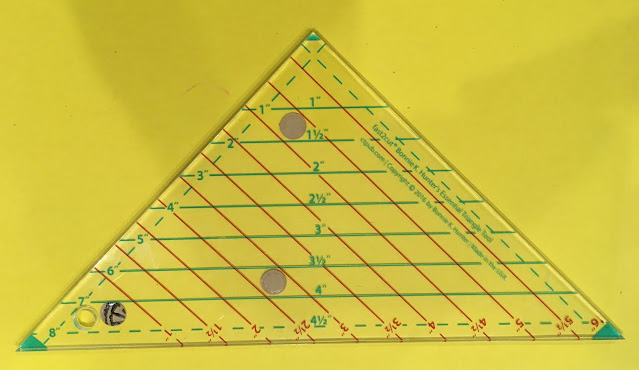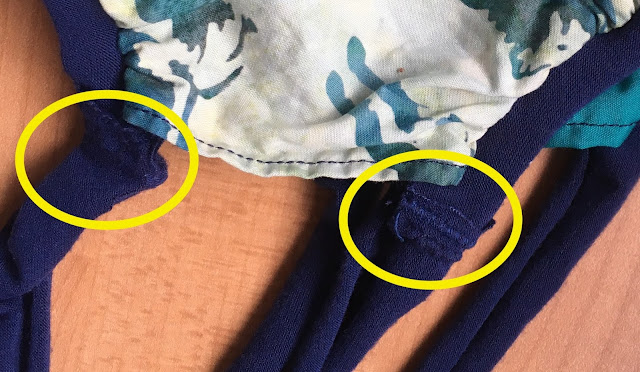Sunday, May 24
Loops and Lycra
I have been provided with some useful information about the ratio of stretchy trim to base fabric: it should be 2 to 3. (Thanks, Gayle!) This piece of information came in handy because I wanted to make myself a mask with ear loops instead of ties so I could get a haircut.
It took some doing, but I finally completed it. I cut a 1-inch wide strip of lycra, then folded it in half and stitched the sides together using the multiple zigzag stitch. Why did I bother with stitching the ear loop? I don't know exactly. It seemed to give the piece more stability without sacrificing too much stretchiness. (See my previous post, Loopla!, for more on lycra ear loops.)
My "Haircut Mask" was made with Kaffe Fassett fabric for the front and for the filter pocket. The back, underneath the pocket, was just some generic orange polka dot fabric I had. I encased one of the new nose bridges (explained below) in between the filter pocket and the back. It will be relatively easy to get to it, if it breaks.
 |
Haircut Mask
The fabric is Leopard Lotus Ochre by Philip Jacobs from the Spring 2016 Kaffe Fassett Collective. |
 |
Filter pocket of Haircut Mask
The fabric is Pink Tree Fungi by Philip Jacobs from the Fall 2016 Kaffe Fassett Collective
|
I love this mask, and it goes on and off so quickly and easily.
Unfortunately, it is very difficult to sew a zigzag stitch on a narrow little strip of Lycra.
First I had to change needle plates, which involves a screwdriver. For regular sewing I prefer to use the Straight Stitch Needle Plate, because it doesn't jam. However, for zigzag stitches it is necessary to use the "Standard" Needle Plate, which has a wide hole so the needle can zigzag from side to side. Then I forgot to take off the Standard Needle Plate before I started sewing the regular fabric again. Oy, did it jam. I couldn't get the fabric out until I unscrewed the plate and took it off.
For those of you who may not be sewing-literate, this is what the Standard Needle Plate (aka throat plate) looks like:
 |
Standard Needle Plate
|
And this is the hole that eats your fabric:
The Straight Stitch Needle Plate has a different configuration of holes:
 |
Straight Stitch Needle Plate
|
Long story short, my beloved Janome is now in the shop. I managed to damage the needle plate while trying to un-jam it. She was way overdue for routine maintenance in any case.
And I want to end this segment by saying that I have also been reminded to use a stretch or ball-point needle when sewing on lycra. I didn't. Maybe that would have made it easier. And maybe I should have lowered the feed dogs. This whole adventure has been one experiment after another.
Locks and Laces
Meanwhile, my daughter received a mask that she really likes because it goes on quickly. It has ties made of plastic lanyard lacing. We used to call it "gimp," and we made lanyards with it at camp. What her mask has actually looks a little wider and more flexible than standard lanyard lace.
The lacing goes through a channel on each side of the mask, so you don't have to worry about sewing through a very narrow piece of plastic.
The really cool thing about this mask is the cord lock toggle that is used to quickly adjust and tighten the ties. You only need one per mask.
Based solely on the photos, I don't really think this is the same exact material campers know and love. You can't see the knots well, but they don't look like the gimp knots that always came undone due to the stiffness and lack of friction I remember from my camping days.
Whatever. I will figure the ties out later. I'm thinking t-shirts might work. In order to be able to experiment, I ordered some cord locks (and they came in just a few days🤗). I was able to get a package of 25 cord locks for $7.29. That works out to about 29 cents apiece. Very reasonable.
A Bridge to Nose-wear
Susan C presciently ordered a bunch of nose bridges very early on in our new lives as mask makers. She was kind enough to share them, and I got two dozen to play with while I waited for my order to arrive.
I placed my order for the same type of nose bridge on April 27. It was a little late in the game, but I carefully chose a supplier (through Amazon) who looked to be able to get them shipped quickly. As soon as I placed the order the expected arrival date changed to a later date. I kept checking the tracking feature and the arrival kept getting pushed back, until the product finally showed up as "currently unavailable." After almost a month, the tracking feature informed me I could request a refund. I did so yesterday, and the seller promptly responded agreeing to give me a refund. An email from Amazon confirmed this, but I want to see it on my credit card.
I did consider not cancelling the order, but Susan C reported that she was finding the pieces rather flimsy, and one of them had broken inside a mask during washing. I think I will get the plastic-covered wire nose bridge strips instead, but I will probably have a long wait.
My Latest Labors
My mask group is working on some masks for the synagogue, in case people show up without a mask. The idea is that people who don't have a mask can keep one. But people who already have one at home should leave them at the synagogue. We are still figuring out a system to collect these weekly and wash them.
Speaking for myself only, I work much too hard on these masks to have them be taken as a souvenir, or because they are "free," or because they are nicer, or because we forgot and walked out wearing it. They are not intended to be throw-away items. So, my solution to this "problem" is to use up some this ugly Judaica fabric that I've had forever. I am halfway through a set of these masks. I will finish them when my Janome comes home.
I also made a pair of masks for one of my cousins in California. She didn't get the sewing gene, apparently. Her masks got the full treatment, with nose bridges and filter pockets and pretty fabric.
 |
The fabric on the top mask is May Purple Fireweed Bali Batik, by Alaskan artist Dana Michelle, from the Into the Wild collection, by Hoffman Fabrics. The fabric on the bottom mask is Red Guinea Flower, from Kaffe Fassett.
|
 |
The filter pocket on the top mask is a batik. The filter pocket on the bottom mask is Leopard Lotus Orange by Philip Jacobs from the Spring 2016 Kaffe Fassett Collective.
|
Now I just have to figure out what I'm going to do with those cord locks. And make about 50 more masks.










































